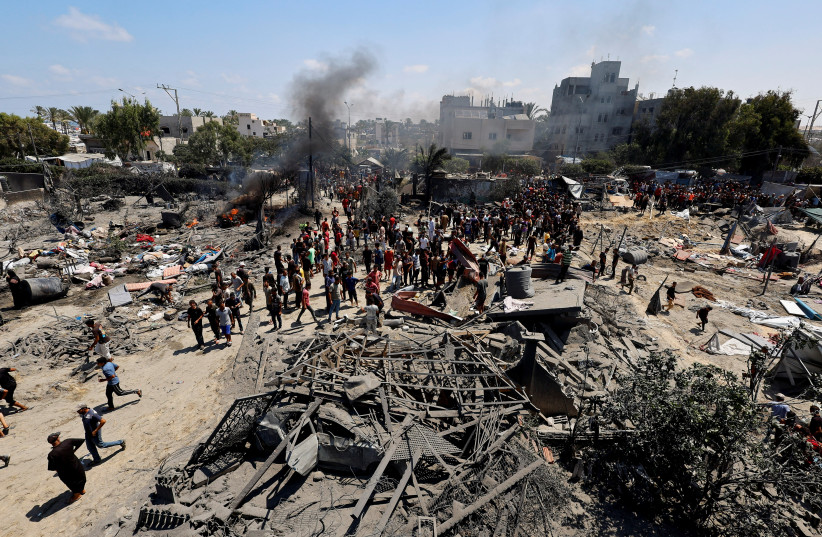In a significant development in the ongoing conflict between Israel and Hamas, an Israeli airstrike in southern Gaza targeted Mohammad Deif, the leader of Hamas’s military wing, the Izzadin al-Qassam Brigades. The strike occurred in the Khan Yunis area, and while Deif’s status remains unclear, the attack resulted in substantial militant casualties.
The Strike and Its Impact
According to Israel’s Army Radio, the airstrike targeted an area in al-Mawasi, west of Khan Yunis, which housed displaced persons. The attack reportedly killed around 20 people and injured over 120 others. The precise operation was executed based on timely intelligence, suggesting a narrow window of opportunity for the strike.

The IDF stated that significant preparation went into the operation, which aimed to eliminate Deif while he was above ground, avoiding the complexities of tunnel warfare. Security sources indicated no hostages were present at the strike location.
Key Targets and Casualties
Alongside Mohammad Deif, another high-profile target was Rafa Salama, the commander of Hamas’s Khan Yunis Brigade. Reports from Al Hadath, a Saudi news outlet, confirmed Salama’s death in the strike. The IDF estimates that dozens of those killed were active Hamas terrorists providing security for Deif and Salama.
Official Responses and Reactions
Hamas officials, including spokesperson Abu Zuhri, dismissed reports of Deif being targeted as “nonsense,” claiming all casualties were civilians. Zuhri condemned the strike as a grave escalation and accused Israel of disinterest in reaching a ceasefire, framing the attack as part of a broader war of genocide supported by American and global silence.
In response, Israel’s Defense Minister Yoav Gallant, IDF Chief of Staff Herzi Halevi, and Shin Bet head Ronen Bar conducted an operational situation assessment. Reports indicated a heavy IDF assault on terrorists in southern Gaza, including significant air force activity and tactical ground maneuvers in the Khan Yunis area.
Civilian Casualties and Humanitarian Concerns
The Hamas-run Gaza health ministry reported that 71 people were killed and over 289 wounded due to the strike. The ministry described the attack as a massacre targeting displaced persons’ tent camps. IDF officials stated they would investigate reports of civilian casualties near Khan Yunis. Local hospitals reportedly evacuated existing patients to accommodate the influx of new casualties from the IDF operations.

Who is Mohammad Deif?
Mohammad Deif, born Mohammad Masri in 1965 in the Khan Yunis Refugee Camp, is a pivotal figure in Hamas’s military operations. He adopted the name “Deif,” meaning “guest,” reflecting his constant movement to evade Israeli attacks. Deif joined Hamas during the first Intifada in 1987 and has since survived numerous assassination attempts, earning a reputation as “the man with nine lives.”
Deif’s strategic expertise includes developing Hamas’s network of terror tunnels and bomb-making capabilities. He played a central role in orchestrating the October 7 attack on southern Israel, which resulted in over 1,200 deaths and more than 250 kidnappings.
Legacy and International Perception
Despite frequent targeting, Deif remains a formidable figure within Hamas and the broader Palestinian resistance. Omri Brinner, an analyst at the International Team for the Study of Security Verona, noted that Deif’s legacy would endure regardless of his fate, given his role in the October 7 attack, deemed the most successful in Palestinian resistance history. Deif has been designated an international terrorist by the U.S. since 2015.
Conclusion
The recent Israeli airstrike targeting Mohammad Deif underscores the ongoing intensity of the Israel-Hamas conflict. While the immediate results of the operation include significant militant casualties, the broader implications for the conflict and potential for escalation remain to be seen. As both sides navigate the complex landscape of warfare, the humanitarian toll continues to mount, raising urgent questions about the path to lasting peace and security in the region.
Further Developments
This situation remains fluid, with potential for further military actions and diplomatic responses. Continued monitoring and analysis will be crucial to understanding the evolving dynamics between Israel and Hamas.
